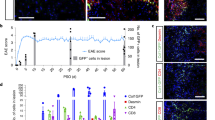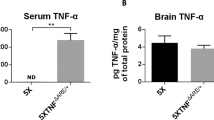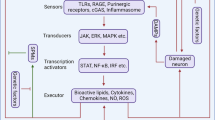Abstract
The use of transgenic technology to over-express or prevent expression of genes encoding molecules related to inflammation has allowed direct examination of their role in experimental disease. This article reviews transgenic and knockout models of CNS demyelinating disease, focusing primarily on the autoimmune disease multiple sclerosis, as well as conditions in which an inflammatory response makes a secondary contribution to tissue injury or repair, such as neurodegeneration, ischemia and trauma.
This is a preview of subscription content, access via your institution
Access options
Subscribe to this journal
Receive 12 print issues and online access
$209.00 per year
only $17.42 per issue
Buy this article
- Purchase on Springer Link
- Instant access to full article PDF
Prices may be subject to local taxes which are calculated during checkout

Stephen Horwitz

Stephen Horwitz
Similar content being viewed by others
References
Owens, T. & Sriram, S. The immunology of multiple sclerosis and its animal model, experimental allergic encephalomyelitis. Neurol. Clin. 13, 51–73 (1995).
Eynon, E.E. & Flavell, R.A. Walking through the forest of transgenic models of human disease. Immunol. Rev. 169, 5–10 (1999).
Litzenburger, T. et al. B lymphocytes producing demyelinating autoantibodies: development and function in gene-targeted transgenic mice. J. Exp. Med. 188, 169–80 (1998).
Hofman, F.M., Hinton, D.R., Johnson, K. & Merrill, J.E. Tumor necrosis factor identified in multiple sclerosis brain. J. Exp. Med. 170, 607–612 (1989).
Selmaj, K., Raine, C.S., Cannella, B. & Brosnan, C.F. Identification of lymphotoxin and tumor necrosis factor in multiple sclerosis lesions. J. Clin. Invest. 87, 949–954 (1991).
Issazadeh, S., Ljungdahl, A., Hojeberg, B., Mustafa, M. & Olsson, T. Cytokine production in the central nervous system of Lewis rats with experimental autoimmune encephalomyelitis: dynamics of mRNA expression for interleukin-10, interleukin-12, cytolysin, tumor necrosis factor alpha and tumor necrosis factor beta. J. Neuroimmunol. 61, 205–212 (1995).
Okuda, Y. et al. Expression of the inducible isoform of nitric oxide synthase in the central nervous system of mice correlates with the severity of actively induced experimental allergic encephalomyelitis. J. Neuroimmunol. 62, 103–112 (1995).
Renno, T., Krakowski, M., Piccirillo, C., Lin, J.Y. & Owens, T. TNF-alpha expression by resident microglia and infiltrating leukocytes in the central nervous system of mice with experimental allergic encephalomyelitis. Regulation by Th1 cytokines. J. Immunol. 154, 944–953 (1995).
Taupin, V. et al. Increased severity of experimental autoimmune encephalomyelitis, chronic macrophage/microglial reactivity, and demyelination in transgenic mice producing tumor necrosis factor-alpha in the central nervous system. Eur. J. Immunol. 27, 905–913 (1997).
Probert, L. et al. TNF-alpha transgenic and knockout models of CNS inflammation and degeneration. J. Neuroimmunol. 72, 137–141 (1997).
Stalder, A.K. et al. Late-onset chronic inflammatory encephalopathy in immune-competent and severe combined immune-deficient (SCID) mice with astrocyte-targeted expression of tumor necrosis factor. Am. J. Pathol. 153, 767–783 (1998).
Akassoglou, K. et al. Oligodendrocyte apoptosis and primary demyelination induced by local TNF/p55TNF receptor signaling in the central nervous system of transgenic mice: models for multiple sclerosis with primary oligodendrogliopathy. Am. J. Pathol. 153, 801–813 (1998).
Eugster, H.P. et al. Severity of symptoms and demyelination in MOG-induced EAE depends on TNFR1. Eur. J. Immunol. 29, 626–632 (1999).
Sedgwick, J.D., Riminton, D.S., Cyster, J.G. & Korner, I. Tumor necrosis factor: a master-regulator of leukocyte movement. Immunol. Today 21, 110–113 (2000).
Bruce, A.J. et al. Altered neuronal and microglial responses to excitotoxic and ischemic brain injury in mice lacking TNF receptors. Nature Med. 2, 788–794 (1996).
Liu, J. et al. TNF is a potent anti-inflammatory cytokine in autoimmune-mediated demyelination. Nature Med. 4, 78–83 (1998).
Hjelmstrom, P., Juedes, A.E. & Ruddle, N.H. Cytokines and antibodies in myelin oligodendrocyte glycoprotein-induced experimental allergic encephalomyelitis. Res. Immunol. 149, 794–804; 847–848; 855–860 (1998).
Gregersen, R., Lambertsen, K. & Finsen, B. Microglia and macrophages are the major source of tumor necrosis factor in permanent middle cerebral artery occlusion in mice. J. Cereb. Blood Flow Metab. 20, 53–65 (2000).
Calabresi, P.A., Tranquill, L.R., McFarland, H.F. & Cowan, E.P. Cytokine gene expression in cells derived from CSF of multiple sclerosis patients. J. Neuroimmunol. 89, 198–205 (1998).
Hofman, F.M., Hinton, D.R., Baemayr, J., Weil, M. & Merrill, J.E. Lymphokines and immunoregulatory molecules in subacute sclerosing panencephalitis. Clin. Immunol. Immunopathol. 58, 331–342 (1991).
Owens, T., Renno, T., Taupin, V. & Krakowski, M. Inflammatory cytokines in the brain: does the CNS shape immune responses? Immunol. Today 15, 566–571 (1994).
Popko, B., Corbin, J.G., Baerwald, K.D., Dupree, J. & Garcia, A.M. The effects of interferon-gamma on the central nervous system. Mol. Neurobiol. 14, 19–35 (1997).
Sethna, M.P. & Lampson, L.A. Immune modulation within the brain: recruitment of inflammatory cells and increased major histocompatibility antigen expression following intracerebral injection of interferon-gamma. J. Neuroimmunol. 34, 121–132 (1991).
Simmons, R.D. & Willenborg, D.O. Direct injection of cytokines into the spinal cord causes autoimmune encephalomyelitis-like inflammation. J. Neurol. Sci. 100, 37–42 (1990).
Voorthuis, J.A. et al. Suppression of experimental allergic encephalomyelitis by intraventricular administration of interferon-gamma in Lewis rats. Clin. Exp. Immunol. 81, 183–188 (1990).
Corbin, J.G. et al. Targeted CNS expression of interferon-gamma in transgenic mice leads to hypomyelination, reactive gliosis, and abnormal cerebellar development. Mol. Cell Neurosci. 7, 354–370 (1996).
Horwitz, M.S., Evans, C.F., McGavern, D.B., Rodriguez, M. & Oldstone, M.B. Primary demyelination in transgenic mice expressing interferon-gamma. Nature Med. 3, 1037–1041 (1997).
Renno, T. et al. Interferon-gamma in progression to chronic demyelination and neurological deficit following acute EAE. Mol. Cell Neurosci. 12, 376–389 (1998).
Jensen, M.B., Hegelund, I.V., Lomholt, N.D., Finsen, B. & Owens, T. IFNγ enhances microglial reactions to hippocampal axonal degeneration. J Neurosci 20, 3612–3621 (2000).
Horwitz, M.S., Evans, C.F., Klier, F.G. & Oldstone, M.B. Detailed in vivo analysis of interferon-gamma induced major histocompatibility complex expression in the the central nervous system: astrocytes fail to express major histocompatibility complex class I and II molecules. Lab Invest. 79, 235–242 (1999).
Turnley, A.M. et al. Dysmyelination in transgenic mice resulting from expression of class I histocompatibility molecules in oligodendrocytes. Nature 353, 566–569 (1991).
Power, C., Kong, P.A. & Trapp, B.D. Major histocompatibility complex class I expression in oligodendrocytes induces hypomyelination in transgenic mice. J. Neurosci. Res. 44, 165–173 (1996).
Baerwald, K.D., Corbin, J.G. & Popko, B. Major histocompatibility complex heavy chain accumulation in the endoplasmic reticulum of oligodendrocytes results in myelin abnormalities. J. Neurosci. Res 59, 160–169 (2000).
Pouly, S., Becher, B., Blain, M. & Antel, J.P. Interferon-gamma modulates human oligodendrocyte susceptibility to Fas-mediated apoptosis. J. Neuropathol. Exp. Neurol. 59, 280–286 (2000).
Willenborg, D.O., Fordham, S., Bernard, C.C., Cowden, W.B. & Ramshaw, I.A. IFN-gamma plays a critical down-regulatory role in the induction and effector phase of myelin oligodendrocyte glycoprotein-induced autoimmune encephalomyelitis. J. Immunol. 157, 3223–3227 (1996).
Tran, E.H., Prince, E.N. & Owens, T. IFN-gamma shapes immune invasion of the central nervous system via regulation of chemokines. J. Immunol. 164, 2759–2768 (2000).
Krakowski, M. & Owens, T. Interferon-gamma confers resistance to experimental allergic encephalomyelitis. Eur. J. Immunol. 26, 1641–1646 (1996).
Chu, C.Q., Wittmer, S. & Dalton, D.K. Failure to suppress the expansion of the activated CD4 T cell population in interferon gamma-deficient mice leads to exacerbation of experimental autoimmune encephalomyelitis. J. Exp. Med. 192, 123–128 (2000).
Billiau, A. et al. Enhancement of experimental allergic encephalomyelitis in mice by antibodies against IFN-gamma. J. Immunol. 140, 1506–1510 (1988).
Duong, T.T., St. Louis, J., Gilbert, J.J., Finkelman, F.D. & Strejan, G.H. Effect of anti-interferon-gamma and anti-interleukin-2 monoclonal antibody treatment on the development of actively and passively induced experimental allergic encephalomyelitis in the SJL/J mouse. J. Neuroimmunol. 36, 105–115 (1992).
Ransohoff, R.M. Mechanisms of inflammation in MS tissue: adhesion molecules and chemokines. J. Neuroimmunol. 98, 57–68 (1999).
Karpus, W.J. et al. An important role for the chemokine macrophage inflammatory protein-1 alpha in the pathogenesis of the T cell-mediated autoimmune disease, experimental autoimmune encephalomyelitis. J. Immunol. 155, 5003–5010 (1995).
Youssef, S. et al. Long-lasting protective immunity to experimental autoimmune encephalomyelitis following vaccination with naked DNA encoding C-C chemokines. J. Immunol. 161, 3870–3879 (1998).
Tani, M. et al. Neutrophil infiltration, glial reaction, and neurological disease in transgenic mice expressing the chemokine N51/KC in oligodendrocytes. J. Clin. Invest. 98, 529–539 (1996).
Fuentes, M.E. et al. Controlled recruitment of monocytes and macrophages to specific organs through transgenic expression of monocyte chemoattractant protein-1. J. Immunol. 155, 5769–5776 (1995).
Fife, B.T., Huffnagle, G.B., Kuziel, W.A. & Karpus, W.J. CC chemokine receptor 2 is critical for induction of experimental autoimmune encephalomyelitis. J. Exp. Med. 192, 899–906 (2000).
Tran, E.H., Kuziel, W.A. & Owens, T. Induction of experimental autoimmune encephalomyelitis in C57BL/6 mice deficient in either the chemokine macrophage inflammatory protein-1alpha or its CCR5 receptor. Eur. J. Immunol. 30, 1410–1415 (2000).
Bettelli, E. et al. IL-10 is critical in the regulation of autoimmune encephalomyelitis as demonstrated by studies of IL-10- and IL-4-deficient and transgenic mice. J. Immunol. 161, 3299–3306 (1998).
Cua, D.J., Groux, H., Hinton, D.R., Stohlman, S.A. & Coffman, R.L. Transgenic interleukin 10 prevents induction of experimental autoimmune encephalomyelitis. J. Exp. Med. 189, 1005–1010 (1999).
Samoilova, E.B., Horton, J.L. & Chen, Y. Acceleration of experimental autoimmune encephalomyelitis in interleukin-10-deficient mice: roles of interleukin-10 in disease progression and recovery. Cell Immunol. 188, 118–124 (1998).
Falcone, M., Rajan, A.J., Bloom, B.R. & Brosnan, C.F. A critical role for IL-4 in regulating disease severity in experimental allergic encephalomyelitis as demonstrated in IL-4-deficient C57BL/6 mice and BALB/c mice. J. Immunol. 160, 4822–4830 (1998).
Genain, C.P. & Zamvil, S.S. Specific immunotherapy: one size does not fit all. Nature Med. 6, 1098–1100 (2000).
Genain, C.P. et al. Late complications of immune deviation therapy in a nonhuman primate. Science 274, 2054–2057 (1996).
Wyss-Coray, T., Borrow, P., Brooker, M.J. & Mucke, L. Astroglial overproduction of TGF-beta 1 enhances inflammatory central nervous system disease in transgenic mice. J. Neuroimmunol. 77, 45–50 (1997).
Johns, L.D. & Sriram, S. Experimental allergic encephalomyelitis: neutralizing antibody to TGF beta 1 enhances the clinical severity of the disease. J. Neuroimmunol. 47, 1–7 (1993).
Racke, M.K. et al. Prevention and treatment of chronic relapsing experimental allergic encephalomyelitis by transforming growth factor-beta 1. J. Immunol. 146, 3012–3017 (1991).
Wyss-Coray, T., Lin, C., Sanan, D.A., Mucke, L. & Masliah, E. Chronic overproduction of transforming growth factor-beta1 by astrocytes promotes Alzheimer's disease-like microvascular degeneration in transgenic mice. Am. J. Pathol. 156, 139–150 (2000).
Campbell, I.L., Stalder, A.K., Akwa, Y., Pagenstecher, A. & Asensio, V.C. Transgenic models to study the actions of cytokines in the central nervous system. Neuroimmunomodulation 5, 126–135 (1998).
Furlan, R. et al. Caspase-1 regulates the inflammatory process leading to autoimmune demyelination. J. Immunol. 163, 2403–2409 (1999).
Eugster, H.P., Frei, K., Kopf, M., Lassmann, H. & Fontana, A. IL-6-deficient mice resist myelin oligodendrocyte glycoprotein-induced autoimmune encephalomyelitis. Eur. J. Immunol. 28, 2178–2187 (1998).
Segal, B.M., Dwyer, B.K. & Shevach, E.M. An interleukin (IL)-10/IL-12 immunoregulatory circuit controls susceptibility to autoimmune disease. J. Exp. Med. 187, 537–46 (1998).
Arnason, B.G. Immunologic therapy of multiple sclerosis. Annu. Rev. Med. 50, 291–302 (1999).
Panitch, H.S., Hirsch, R.L., Schindler, J. & Johnson, K.P. Treatment of multiple sclerosis with gamma interferon: exacerbations associated with activation of the immune system. Neurology 37, 1097–1102 (1987).
Bever, C.T., Jr., Panitch, H.S., Levy, H.B., McFarlin, D.E. & Johnson, K.P. Gamma-interferon induction in patients with chronic progressive MS. Neurology 41, 1124–1127 (1991).
Ling, Z.D. et al. Intravenous immunoglobulin induces interferon-gamma and interleukin-6 in vivo. J. Clin. Immunol. 13, 302–309 (1993).
Selmaj, K.W. & Raine, C.S. Experimental autoimmune encephalomyelitis: immunotherapy with anti-tumor necrosis factor antibodies and soluble tumor necrosis factor receptors. Neurology 45, S44–S49 (1995).
The Lenercept Multiple Sclerosis Study Group and The University of British Columbia MS/MRI Analysis Group. TNF neutralization in MS: results of a randomized, placebo-controlled multicenter study. Neurology 53, 457–465 (1999).
Wiendl, H., Neuhaus, O., Kappos, L. & Hohlfeld, R. [Multiple sclerosis. Current review of failed and discontinued clinical trials of drug treatment]. Nervenarzt. 71, 597–610 (2000).
Green, E.A. & Flavell, R.A. The temporal importance of TNFα expression in the development of diabetes. Immunity 12, 459–469 (2000).
Martin, D. & Near, S.L. Protective effect of the interleukin-1 receptor antagonist (IL-1ra) on experimental allergic encephalomyelitis in rats. J. Neuroimmunol. 61, 241–245 (1995).
Leonard, J.P., Waldburger, K.E. & Goldman, S.J. Prevention of experimental autoimmune encephalomyelitis by antibodies against interleukin 12. J. Exp. Med. 181, 381–386 (1995).
Cash, E. et al. Macrophage-inactivating IL-13 suppresses experimental autoimmune encephalomyelitis in rats. J. Immunol. 153, 4258–4267 (1994).
Jander, S. & Stoll, G. Differential induction of interleukin-12, interleukin-18, and interleukin-1beta converting enzyme mRNA in experimental autoimmune encephalomyelitis of the Lewis rat. J. Neuroimmunol. 91, 93–99 (1998).
Wildbaum, G., Youssef, S., Grabie, N. & Karin, N. Neutralizing antibodies to IFN-gamma-inducing factor prevent experimental autoimmune encephalomyelitis. J. Immunol. 161, 6368–6374 (1998).
Asensio, V.C. et al. C10 is a novel chemokine expressed in experimental inflammatory demyelinating disorders that promotes recruitment of macrophages to the central nervous system. Am. J. Pathol. 154, 1181–1191 (1999).
Acknowledgements
T.O. thanks B. Finsen and J. Zimmer for their hospitality while writing this.
Author information
Authors and Affiliations
Corresponding author
Rights and permissions
About this article
Cite this article
Owens, T., Wekerle, H. & Antel, J. Genetic models for CNS inflammation. Nat Med 7, 161–166 (2001). https://doi.org/10.1038/84603
Issue Date:
DOI: https://doi.org/10.1038/84603
This article is cited by
-
Role for microglia in sex differences after ischemic stroke: importance of M2
Metabolic Brain Disease (2015)
-
Role of phospholipase A2s and lipid mediators in secondary damage after spinal cord injury
Cell and Tissue Research (2012)
-
Haplotype-based case–control study of receptor (calcitonin) activity-modifying protein-1 gene in cerebral infarction
Journal of Human Hypertension (2010)
-
Modeling multiple sclerosis in laboratory animals
Seminars in Immunopathology (2009)
-
Temporal expression and cellular origin of CC chemokine receptors CCR1, CCR2 and CCR5 in the central nervous system: insight into mechanisms of MOG-induced EAE
Journal of Neuroinflammation (2007)



